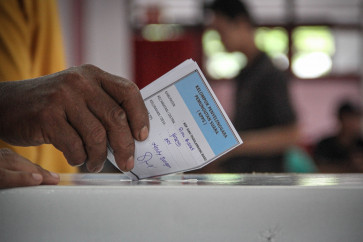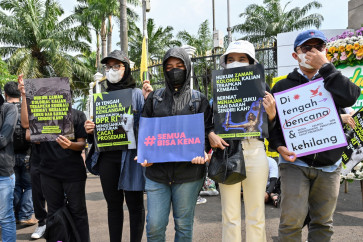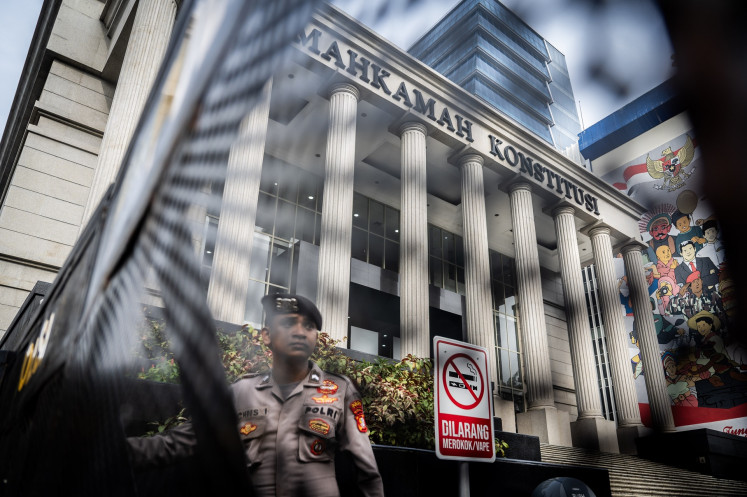Popular Reads
Top Results
Can't find what you're looking for?
View all search resultsPopular Reads
Top Results
Can't find what you're looking for?
View all search resultsTayub Festival, dispelling crude eroticism
Sensuality, unrefined movements and captivating smiles from the dancers are usually the main attraction of tayub, a traditional dance in which male members of the audience are enticed to join
Change text size
Gift Premium Articles
to Anyone
S
ensuality, unrefined movements and captivating smiles from the dancers are usually the main attraction of tayub, a traditional dance in which male members of the audience are enticed to join. This is coupled with the dancers’ tempting kemben or breast cloths, crude makeup and rustic perfumes.
With such clothing and grooming, tayub dancers sway rhythmically on stage or the floor, almost mixing with the audience in a reveling atmosphere, even more so as the night wears on. With Javanese song and gamelan accompaniment, the dancers are seemingly overwhelmed by passionate desire.
However, such sensuality and other allures seemed to evaporate in the Nusantara Tayub Festival organized by the Indonesian Arts Institute (ISI) Surakarta, the Javanology Institute of Sebelas Maret University (UNS) and the Kertagama Foundation on April 8 to 9. Five tayub troupes participated: Pakasa (from Sragen, Central Java), Pring Sedapur (Banyumas, Central Java), Sekar Budaya (Malang, East Java), Sida Paksa (Banyuwangi, East Java), and Among Raos (Blora, Central Java). Three others were unable to attend.
Unlike when they are hired to dance at wedding ceremonies or other such occasions, the festival participants danced with restraint and gave a rather formal impression, as if lacking the soul as well as the grassroots and sensual sides of the art. Yet, the event was still appealing as it retained the folk dance’s amusing and entertaining features.
“The purpose of this festival is to dispel the negative idea that tayub is a vulgar erotic dance. We’re trying to preserve the art rather than the countrified movements,” said ISI Surakarta rector Slamet Suparno when opening the festival.
Panglaras, the title of a dance presented by ISI lecturers and students, opened the celebration. It tells the story of court dancers asked to divert the concentration of a crown prince while the king gives him some advice. When a prince is ready for the throne, he must not allow himself to be tempted by the
dancers’ passionate motions.
Pakasa from Sragen appeared on the first day, with two women dancing gently until several men emerged with attractive yet comic movements, wearing bizarre costumes and moustaches.
As the drum beats got louder, the dancers encouraged spectators to join them. In a moment, the women put their sashes over the shoulders of members of the audience as a gesture of invitation. One of them was ISI rector Slamet.
Among the enthusiastic onlookers were a number of foreign tourists. Charlie, a US visitor, even joined the dance several times. “I’ve frequently watched tayub performances, including those to mark village ceremonies. For me, the dance is exciting. Though often seen as vulgar, it actually has a high artistic value,” he said.
Up next was Pringsedapur from Banyumas, with its typical calung or bamboo gamelan, playing the melody of “Sekar Gadhung”. According to troupe leader Darno Kartawi, “Sekar Gadhung” always opens his show because it is believed to have the sacred power of invoking the spirits of legendary lengger (dancers) of the past. This opening was presented by male dancers dressed in women’s costumes, complete with makeup.
The Banyumas group later played “Renggong Lor” to present famous Yogyakarta dancer and choreographer Didik Nini Thowok. Didik’s comic dances are always exhilarating. Throughout his performance the audience kept laughing, particularly when he wore his unique and funny masks or interspersed jaipong (West Java dance) movements into his set.
The show was even more absorbing when several public figures were invited to dance, including former New Order information minister Harmoko and once again the ISI rector. Harmoko is a founder of the Kertagama Foundation, who initiated the festival.
Sekar Budaya from Malang boasted a ledhek (local term for dancer), who was singing while dancing. Her movements were more refined. Only when the drum beat harder did she move sensually. In Banyuwangi, tayub is better known as gandrung.
The second day saw performances by Sida Paksa from Banyuwangi and Among Raos from Blora, both with impressive variants of tayub that enlivened the stage. Sida Paksa’s Gandrung Banyuwangi with several patriotic songs managed to entice spectators to join in the dance.
“In the colonial period, tayub became an anticolonial movement. It’s not surprising that many local songs have heroic verses against colonizers,” said Sida Paksa group leader, Sahuni.
Among Raos was represented by three dancers with their graceful motions. They were moving slowly as if attempting to keep their sensuality within proper confines. In Blora, the art is still widely performed at various parties held by village people.
Gembong Setyo Pujiono, a member of Among Raos, said his group’s dancers were fairly highly paid, ranging from Rp 400,000 (US$45) to Rp 1 million each for a show in the city, this could be even higher outside Blora.
“Now the city has around 80 professional tayub dancers with about 35 gamelan groups accompanying them. For the Blora community, tayub has remained a highly valued art,” added Gembong.
In Sragen, dancers are paid as a group about Rp 10 million. Usually a group is composed of four dancers and several gamelan players. But in Sragen, tayub troupes are less in demand than campursari, a blend of gamelan and contemporary music.
“As an entertainment, campursari may be more modern. But tayub continues to exist especially in peripheral areas where this tradition is rooted. For these people, the art has to be carried on and preserved,” said Santosa from Pakasa.
The festival was well attended, with the ISI terrace hall packed by visitors for two successive evenings. The audiences not only watched the performances but also enthusiastically took part on stage.
Its strong roots in regional communities and its role in providing public entertainment and increasing social cohesion make the preservation of this art a necessity. Therefore, the Education and Culture Ministry is striving to register tayub on the UNESCO list of world heritage after batik, wayang (puppet shows) and kris (ornamental daggers).
“We’ve formed a National Heritage Committee because before being proposed to UNESCO, tayub has to belong to the national cultural heritage first,” said Deputy Education and Culture Minister for cultural affairs, Wiendu Nuryati, after the festival’s opening.










